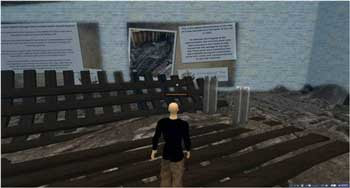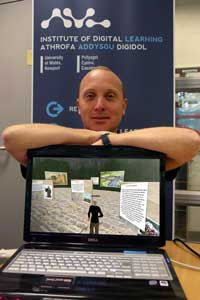Medieval History
 Local residents and history enthusiasts will now have the opportunity to explore Newport?s medieval past and see how the medieval castle and ship may have looked in the 15th century, by visiting an online virtual museum.
Local residents and history enthusiasts will now have the opportunity to explore Newport?s medieval past and see how the medieval castle and ship may have looked in the 15th century, by visiting an online virtual museum.
The University of Wales, Newport will this week reveal an interactive visualisation of the ship that allows people to walk around the ship?s underwater remains and visit a 3D museum containing historical information and publications.
Matt Chilcott, Development Director at the University of Wales, Newport?s, Institute of Digital Learning, (pictured left), said, ?This innovative digital approach enables Newport to share its rich heritage with a range of audiences all over the world in a new and exciting way. For example, tourists planning to visit Newport can now have fun exploring the area?s history before they even arrive in Wales.?
This project forms part of the University?s new Digital Heritage Zone in Second Life, a virtual world that can be accessed through the internet in which it is possible to explore virtual places and interact with other people through a 3D character.
The online 3D museum shows how the ship would have fitted into the medieval historic landscape of Newport, and tells the story of the ship and mysteries surrounding it that are still being unravelled.
 Matt Chilcott added, ?This cutting-edge project in the field of digital heritage is an example of the work we are doing here at the University to explore how online 3D technologies can be used to help visualise history, and bring it to life as an effective learning, teaching and public engagement medium.?
Matt Chilcott added, ?This cutting-edge project in the field of digital heritage is an example of the work we are doing here at the University to explore how online 3D technologies can be used to help visualise history, and bring it to life as an effective learning, teaching and public engagement medium.?
The project will be unveiled at the University?s South Wales Centre for Historical and Interdisciplinary Studies lecture entitled ?Digital Heritage in Action? taking place on Thursday 29 April, 5pm at the Caerleon Campus, University of Wales, Newport.
The virtual museum has been developed in collaboration with the Friends of Newport Ship, Newport Past, and the People?s Collection Wales. The Institute of Digital Learning works in partnership with industry, government, academia and charities to develop flexible learning experiences to meet knowledge and skills development needs. The Institute specialises in innovating creative approaches to learning and knowledge exchange online, on mobiles and in virtual worlds, such as the Digital Heritage Zone.
Click here to go to the Newport's Virtual Medieval Museum
Click here to watch a video about the project
Source: University of Wales
- Newport?s Medieval Ship Could Have Been Basque
The origins of the Newport Medieval Ship may have finally been solved ? with new research announced yesterday pointing to the north of Spain. Thanks to recent advances in tree-ring dating, experts have obtained the first scientific evidence that...
- Newport's Medieval Ship Set To Mark Decade Of Discovery
A decade of the Newport Medieval Ship will be celebrated next month at the site of the original discovery. ?The Newport Medieval Ship: A Decade of Discovery? event will be held at The Riverfront on June 1. Visitors will be taken on a journey from...
- Developers Sought For Museum For Medieval Newport Ship
A medieval ship discovered on the banks of the River Usk in Newport in 2002 could be a step closer to finding a home. Newport Council has put a tender out to developers asking them to recommend a suitable location for the vessel. It is seeking a...
- Sealing The Fate Of The Newport Ship
The Newport Ship is at the heart of a new collaboration that gets underway this week between the University of Wales Trinity Saint David, the British Museum and Cardiff University. European funding will allow new research on what kept the ship watertight:...
- Model Replica Of Medieval Newport Ship Being Built
An accurate model replica of one of the most precious medieval maritime finds of recent times in Wales will soon be complete - thanks to an innovative manufacturing process perfected at Cardiff University. The Newport Medieval Ship, which dates back...
Medieval History
Virtual Medieval Museum created in Second Life

The University of Wales, Newport will this week reveal an interactive visualisation of the ship that allows people to walk around the ship?s underwater remains and visit a 3D museum containing historical information and publications.
Matt Chilcott, Development Director at the University of Wales, Newport?s, Institute of Digital Learning, (pictured left), said, ?This innovative digital approach enables Newport to share its rich heritage with a range of audiences all over the world in a new and exciting way. For example, tourists planning to visit Newport can now have fun exploring the area?s history before they even arrive in Wales.?
This project forms part of the University?s new Digital Heritage Zone in Second Life, a virtual world that can be accessed through the internet in which it is possible to explore virtual places and interact with other people through a 3D character.
The online 3D museum shows how the ship would have fitted into the medieval historic landscape of Newport, and tells the story of the ship and mysteries surrounding it that are still being unravelled.

The project will be unveiled at the University?s South Wales Centre for Historical and Interdisciplinary Studies lecture entitled ?Digital Heritage in Action? taking place on Thursday 29 April, 5pm at the Caerleon Campus, University of Wales, Newport.
The virtual museum has been developed in collaboration with the Friends of Newport Ship, Newport Past, and the People?s Collection Wales. The Institute of Digital Learning works in partnership with industry, government, academia and charities to develop flexible learning experiences to meet knowledge and skills development needs. The Institute specialises in innovating creative approaches to learning and knowledge exchange online, on mobiles and in virtual worlds, such as the Digital Heritage Zone.
Click here to go to the Newport's Virtual Medieval Museum
Click here to watch a video about the project
Source: University of Wales
- Newport?s Medieval Ship Could Have Been Basque
The origins of the Newport Medieval Ship may have finally been solved ? with new research announced yesterday pointing to the north of Spain. Thanks to recent advances in tree-ring dating, experts have obtained the first scientific evidence that...
- Newport's Medieval Ship Set To Mark Decade Of Discovery
A decade of the Newport Medieval Ship will be celebrated next month at the site of the original discovery. ?The Newport Medieval Ship: A Decade of Discovery? event will be held at The Riverfront on June 1. Visitors will be taken on a journey from...
- Developers Sought For Museum For Medieval Newport Ship
A medieval ship discovered on the banks of the River Usk in Newport in 2002 could be a step closer to finding a home. Newport Council has put a tender out to developers asking them to recommend a suitable location for the vessel. It is seeking a...
- Sealing The Fate Of The Newport Ship
The Newport Ship is at the heart of a new collaboration that gets underway this week between the University of Wales Trinity Saint David, the British Museum and Cardiff University. European funding will allow new research on what kept the ship watertight:...
- Model Replica Of Medieval Newport Ship Being Built
An accurate model replica of one of the most precious medieval maritime finds of recent times in Wales will soon be complete - thanks to an innovative manufacturing process perfected at Cardiff University. The Newport Medieval Ship, which dates back...
